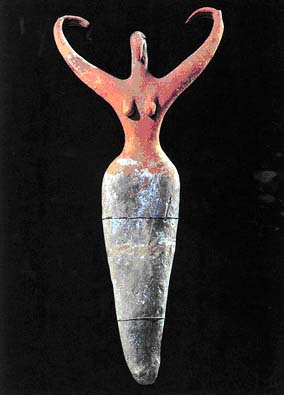|

|
Female Figurine ("Bird Lady"). Egypt, from Ma'mariya. Predynastic Period, Naqada II, circa 3650-3300 B.C. Terracotta. Brooklyn Museum.
|
Ancient Egypt is known for its colorful prehistoric culture. Agricultural tribes working along the Nile developed a highly advanced pottery making art.
The earliest work of Egyptian pottery is the Female Figurine ("Bird Lady") dating back to the Predynastic Period of Egypt(circa 3500 B.C.). The standing figure is 28 centimeters tall with no hair or facial features engraved on the oval-shaped small head. The upper part of the figure is naked and painted red, with clear curves that represent a woman's body and a pair of small breasts. The lower part of the body is the color of dust, resembling a simple tube skirt. With both hands curved overhead, the figure seems like a dancing bird.
The highly abstract statue reflects the distinctive characters of the ancient Egyptian sculpture, which placed an emphasis on viewing a figure as a whole, without focusing on particular physical details. Simple and abstract, the ancient Egyptian sculpture works are quite modernistic as it were.
|

|
Statue pair of Prince Rahotep and his beautiful wife Nofret, Egyptian Museum, Cairo
|
The statues were discovered at their mastaba at Meidum. The statues themselves are life size are are remarkably well preserved with the original paint pretty much intact. He is sitting on a seat with a high backrest, his right arm bent over his chest and his left placed on his thigh, and his hands clenched. He wears a short kilt tied under his belly with a knot. He has short hair and a thin mustache. A heart shaped amulet hangs around his neck. His wife Nofret, designated as "one known to the king," is likewise seated, and places both hands over her chest. She wears a heavy shoulder length wig, encircled by a diadem ornamented with rosettes. Part of her natural hair is visible at the front. She is enveloped in a long mantle under which appear the halters of her tight-fitting dress. A broad collar composed of concentric rings of colored beads adorns her breast.
In accordance with artistic conventions, the man's skin is painted ochre brown and the woman a pale cream color. Their eyes are inlaid in a copper frame: the retina is made of opaque quartz and the pupil of rock crystal. On the high backrest, the name and the titles of the statue's owners are written in black hieroglyphs.
Rahotep was a prince of the Fourth Dynasty in ancient Egypt. The painted limestone statues of he and his wife Nofret represent the style of the ancient Egyptian royal statuary. The figures sit straight with their legs kept together. Usually, men are depicted with their right hands on their chests and left hands on their knees; women, poker-faced, fold their arms on their chests.
